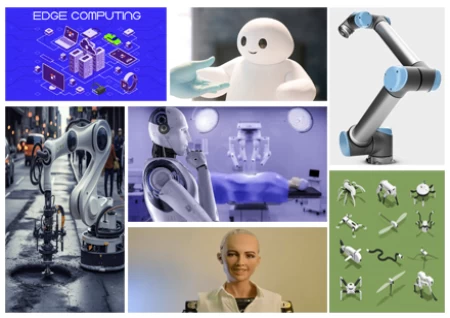Top 7 Robotics Trends That Will Shape 2025

Robotics are already going into overdrive future, we can expect several trends that will transform industries. Daily life also stands to change apart from improvement in human abilities. Here are the top 7 robotics trends that will shape 2025.
1. Collaborative Robots (Cobots)
Cobot - Between 2025, the development of cobots (Collaborative Robots) that are meant to safely collaborate with humans will be observed. Such robots are more likely to be in the form of compact, user-friendly, and affordable ones, which would enable small and medium-sized businesses to implement them into operations. These cobots will be applied in various industries, such as manufacturing, healthcare, and agriculture, where seamless collaboration between humans and robots for performing various tasks will be considered.
2. AI-Powered Autonomous Robots
With improvements in artificial intelligence, AI-Powered autonomous robots will be developed and work alone, interacting with their environment without humans controlling them. Applications in logistic, warehousing, retail, and home assistance will expand rapidly, increase productivity, and reduce operational costs.
3. Robots in Healthcare
Healthcare robots are of great importance for future surgeries, rehabilitation activities, and care for the elderly. More precise and minimally invasive, AI-driven surgical robots will be used in surgery. Robotics designed to care will assist older citizens with daily tasks to enhance the quality of their life, thus providing support and companionship.
4. Swarm Robotics
Swarm robotics is inspired by insects and deals with a massive number of small robots working together in collaboration towards common goals. Swarm robots will be deployed in disaster response, environmental monitoring, and precision agriculture by 2025. Together, they will cover more space than any individual robot because they could work together.
5. Soft Robotics
Soft robotics is the development of soft, adaptive robots similar to dexterous living organisms. Soft robots will increasingly be used in delicate tasks like healthcare applications, food handling, and some manufacturing jobs. Soft robots would excel in situations where rigid robots are not effective.
6. Humanoid Robots
Humanoid robots will continue to advance with more efficient motor capabilities, AI-based communication, and human-like interaction skills. They are expected to be used in 2025 in customer service, entertainment, and educational activities. These will be job-related functions that incorporate social and emotional intelligence with lifelike interactions.
7. Edge Computing and 5G Integration
The integration with 5G and edge computing would help in faster processing by robots for nearer to the environment real-time decision-making. Better performance of autonomous vehicles, drones, or industrial robots working in smart factories doing tasks in real time would be developed through reduced latency.
Such trends indicate the fusion of AI, machine learning, material science, and connectivity to generate the propulsion of using not only smarter and more adaptable robots but other capabilities in a wide range of industries.
Related queries to this article
- Robotic trends
- collaborative robots
- AI-powered robots
- healthcare robots
- swarm robotics
- soft robotics
- humanoid robots
- 5G Integration
Read more articles and stories on InstaSity Trending Topics.